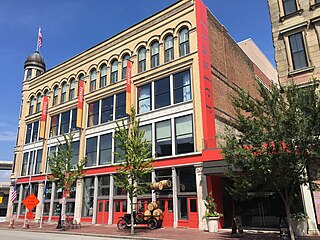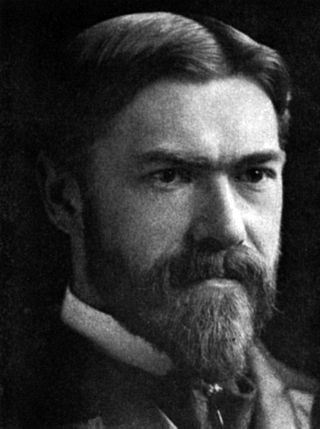
The Pergamon Museum is a listed building on the Museum Island in the historic centre of Berlin, Germany. It was built from 1910 to 1930 by order of Emperor Wilhelm II and according to plans by Alfred Messel and Ludwig Hoffmann in Stripped Classicism style. As part of the Museum Island complex, the Pergamon Museum was added to the UNESCO World Heritage List in 1999 because of its architecture and testimony to the evolution of museums as architectural and social phenomena.

The Higgins Armory Museum is the name of a collection in the Worcester Art Museum. It was formerly a separate museum located in the nearby Higgins Armory Building in Worcester, Massachusetts, dedicated to the display of arms and armor. It was "the only museum in the country devoted solely to arms and armor" and had the second largest arms and armor collection in the country from its founding in 1931 until 2004, behind the Metropolitan Museum of Art in New York City. The collection consists of 2,000 objects, including 24 full suits of armor. The museum closed at the end of 2013 due to a lack of funding. Its collection and endowment were transferred and integrated into the Worcester Art Museum, with the collection on show in its own gallery. The former museum building was sold in December 2014 and now serves as a local events venue.

Kabuto is a type of helmet first used by ancient Japanese warriors that, in later periods, became an important part of the traditional Japanese armour worn by the samurai class and their retainers in feudal Japan.

The Frazier History Museum, previously known as the Frazier Historical Arms Museum and the Frazier International History Museum, is a Kentucky history museum located on Museum Row in the West Main District of downtown Louisville, Kentucky.

The German Historical Museum, known by the acronym DHM, is a museum in Berlin, Germany devoted to German history. It describes itself as a place of "enlightenment and understanding of the shared history of Germans and Europeans". It is often viewed as one of the most important museums in Berlin and is one of the most frequented. The museum is located in the 17th century Zeughaus (armory) on the Unter den Linden, just across the Spree from Museum Island. The museum's attached Exhibition Hall was designed by I. M. Pei in the late 20th Century. Zeughaus is closed since 2021.

St. Anne's Museum Quarter was previously an Augustinian nunnery, St. Anne's Priory. Since 1915 it has housed St. Anne's Museum, one of Lübeck's museums of art and cultural history containing Germany's largest collection of medieval sculpture and altar-pieces, including the famous altars by Hans Memling, Bernt Notke, Hermen Rode, Jacob van Utrecht and Benedikt Dreyer.

The ō-yoroi (大鎧) is a prominent example of early Japanese armor worn by the samurai class of feudal Japan. The term ō-yoroi means "great armor."

Men-yoroi (面鎧), also called menpō (面頬) or mengu (面具), are various types of facial armour that were worn by the samurai class and their retainers in feudal Japan. These include the sōmen, menpō, hanbō or hanpō, and happuri.

Hamburger Bahnhof is the former terminus of the Berlin–Hamburg Railway in Berlin, Germany, on Invalidenstrasse in the Moabit district opposite the Charité hospital. Today it serves as a contemporary art museum, the Museum für Gegenwart, part of the Berlin National Gallery.

Johann Peter Theodor Janssen was a German historical painter.

Bashford Dean was an American zoologist, specializing in ichthyology, and at the same time an expert in medieval and modern armor. He is the only person to have held concurrent positions at the American Museum of Natural History and the Metropolitan Museum of Art, where he was Honorary Curator of Arms and Armor; the Metropolitan Museum purchased his collection of arms and armor after his death.
The Antikensammlung Berlin is one of the most important collections of classical art in the world, now held in the Altes Museum and Pergamon Museum in Berlin, Germany. It contains thousands of ancient archaeological artefacts from the ancient Greek, Roman, Etruscan and Cypriot civilizations. Its main attraction is the Pergamon Altar and Greek and Roman architectural elements from Priene, Magnesia, Baalbek and Falerii. In addition, the collection includes a large number of ancient sculptures, vases, terracottas, bronzes, sarcophagi, engraved gems and metalwork.

The Ethnological Museum of Berlin is one of the Berlin State Museums, the de facto national collection of the Federal Republic of Germany. It is presently located in the Humboldt Forum in Mitte, along with the Museum of Asian Art. The museum holds more than 500,000 objects and is one of the largest and most important collections of works of art and culture from outside Europe in the world. Its highlights include important objects from the Sepik River, Hawaii, the Kingdom of Benin, Cameroon, Congo, Tanzania, China, the Pacific Coast of North America, Mesoamerica, the Andes, as well as one of the first ethnomusicology collections of sound recordings.

The Edoardo Chiossone Museum of Oriental Art in Genoa, Italy is an important collection of Asian art, one of the most significant collections in Europe and in Italy, along with the museums of Venice and Rome.

The Bröhan Museum is a Berlin state museum for Art Nouveau, Art Deco, and Functionalism, located in Berlin's Charlottenburg district. The Museum is named after its founder, entrepreneur and art collector Karl. H. Bröhan (1921–2000), who donated his collection to the state of Berlin on the occasion of his 60th birthday. In 1983, the Bröhan Museum opened in its current space, which belongs to the Charlottenburg Palace ensemble and was originally built for the guard regiment. Since 1994, it has been a state museum.

The Museum of Islamic Art is located in the Pergamon Museum and is part of the Staatliche Museen zu Berlin.

The Humboldt Forum is a museum dedicated to human history, art and culture, located in the Berlin Palace on the Museum Island in the historic centre of Berlin. It is named in honour of the Prussian scholars Wilhelm and Alexander von Humboldt. Considered the "German equivalent" of the British Museum, the Humboldt Forum houses the non-European collections of the Berlin State Museums, temporary exhibitions and public events. Due to the COVID-19 pandemic, it opened digitally on 16 December 2020 and became accessible to the general public on 20 July 2021.

The Ann and Gabriel Barbier-Mueller Museum, also known as The Samurai Collection, is a museum of samurai armor located at 2501 North Harwood Street, Dallas, Texas, USA. It contains nearly three hundred Japanese samurai objects, including suits of armor, helmets, masks, horse armor, and weaponry, dating from the 12th to the 19th century AD with a focus on the Edo period.

Wiebke Siem is a German mixed media artist of German and Polish heritage, winner of the prestigious Goslarer Kaiserring in 2014 as "one of the most innovative and original artists who has never compromised in their art and whose sculptures have a tremendous aura and presence because they mix the familiar and the unfamiliar, the known and the unknown".

Sascha Wiederhold, was a German painter, graphic artist and stage designer.




















